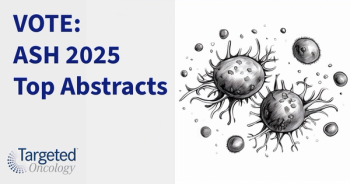
Nutlin Antagonist Shows Activity in Polycythemia Vera
The investigational Nutlin family antagonist idasanutlin demonstrated significant activity and was well tolerated after multiple cycles of exposure in patients with refractory polycythemia vera.<br />
John Mascarenhas, MD
The investigational Nutlin family antagonist idasanutlin demonstrated significant activity and was well tolerated after multiple cycles of exposure in patients with refractory polycythemia vera (PV).
Data from a 2-part single-institution, open-label, dose-escalation phase I study showed a 75% overall response rate when idasanutlin was given as a monotherapy or in combination with pegylated interferon, said John Mascarenhas, MD, at the 2017 ASH Annual Meeting.
In addition, normalization of the hematologic profile and an improvement in the symptom burden were observed with monotherapy as well as with combination therapy.
Downregulation of p53 by MDM2 overexpression inhibits p53 transcription transactivation and facilitates its export from the nucleus. Nutlins are classes of agents that block the MDM2-p53 interaction, thereby activating the p53 pathway, explained Mascarenhas, assistant professor of medicine, hematology, and medical oncology, Icahn School of Medicine at Mount Sinai, New York City. PV CD34 cells contain higher levels of MDM2 compared with normal control cells. Low doses of nutlin, an MDM2 antagonist, increase p21 and PUMA (p53-upregulated modulator of apoptosis) protein levels downstream of p53 in PV CD34 cells to promote apoptosis.
Treatment with low doses of nutlin and pegylated interferon have been shown to reduce the number ofJAK2-mutated primary cells from patients with PV or myelofibrosis transplanted in the immunocompromised mouse in preclinical studies. When combined, nutlins and pegylated interferon are synergistic in this regard.
The hypothesis for the phase I study was that idasanutlin, an MDM2 antagonist, alone or in combination with low-dose pegylated interferon, would result in selective reduction or elimination of myeloproliferative neoplasm cells in patients with PV. In part A, 2 doses of idasanutlin were evaluated: 100 mg and 150 mg daily for 5 consecutive days in 28-day cycles.
Eligibility criteria for the study wereJAK2-mutated PV or essential thrombocythemia (ET), age ≥60 years or a history of thrombosis, previous treatment with at least 1 other agent to which they were intolerant or resistant.
Dose-limited toxicity (DLT) was evaluated at 56 days. DLT was defined as a non-hematologic adverse event of grade ≥3. Hematologic adverse events (AEs) explored were grade ≥2 thrombocytopenia, or grade ≥3 neutropenia or anemia. “If you didn’t have a DLT after the first 56 days, you could continue receiving this drug every 28 days, 5 days in a row, once a day, and you could keep going,” said Mascarenhas. Patients who did not attain at least a partial response (PR) by modified European LeukemiaNet (ELN) criteria after cycle 6 and met the eligibility criteria were able to continue receiving idasanutlin in combination with pegylated interferon-alpha, 45 µg weekly (part B).
Twelve patients (11 with PV and 1 with ET) were treated as part of the study. Their median age was 63.5 years and their median disease duration was 5.4 months. Twelve patients received hydroxyurea (Hydrea) previously, of whom 10 failed to respond. The median variant allele frequency (VAF) ofJAK2V617F was 40.6%; 1 patient had a p53 inactivating mutation. Baseline MDM2 levels were higher in study participants versus controls.
On-target p53 activation was demonstrated with idasanutlin by an increase in plasma levels of MIC-1, said Mascarenhas.
The median number of cycles administered was 9 and the median duration on study was almost 1 year. There were no DLTs. “Some patients didn’t even need to be treated every month; they got treatment holidays,” he said. “That’s unique.” For example, 1 patient didn’t require treatment for 9 months after the third treatment cycle.
Five patients came off the study, 3 who discontinued treatment due to patient decision and 2 who discontinued at investigator discretion.
Idasanutlin was well tolerated. There were 3 grade 3 non-hematologic treatment-emergent AEs (fatigue, headache, and pain) and no grade 4 non-hematologic AEs. There were no hematologic AEs of any grade. Gastrointestinal (GI) toxicity was a concern at the outset of the trial, said Mascarenhas, but no grade ≥3 GI events were observed. “We were aggressive with prophylaxis upfront,” he said.
Eleven of the 12 patients were evaluable following 6 cycles of idasanutlin monotherapy in part A. Four patients were non-responders and were treated with concurrent pegylated interferon in part B, 3 had PRs, and 4 had complete responses (CRs). Among the 4 patients who entered part B, 3 were evaluable. The patient with a p53 mutation was a nonresponder, 1 patient had a PR and 1 had a CR. The combined response rate (parts A and B) was 75%.
Eight of 12 patients had a ≥50% reduction in their total symptom score, a reduction that is considered clinically meaningful.
The median reduction inJAK2V617F VAF was 43%, with 1 patient achieving a 92% reduction. After 6 cycles, 3 patients were eligible for bone marrow biopsy review. One case showed histologic improvement, with normalization of overall marrow cellularity and megakaryocyte number, and less pronounced megakaryocytic atypia. One patient had elimination of grade-1 fibrosis.
A global multicenter single-arm phase II trial of idasanutlin in patients with hydroxyurea-resistant or intolerant PV is currently enrolling patients (NCT03287245). Based on the phase I data, the recommended phase II dose of idasanutlin was selected as 150 mg.
Reference:
Mascarenhas J, Lu M, Virtgaym E, et al. Open label phase I study of single agent oral RG7388 (idasanutlin) in patients with polycythemia vera and essential thrombocythemia. Presented at: 2017 ASH Annual Meeting; December 9-12, 2017; Atlanta, GA. Abstract 254.









































